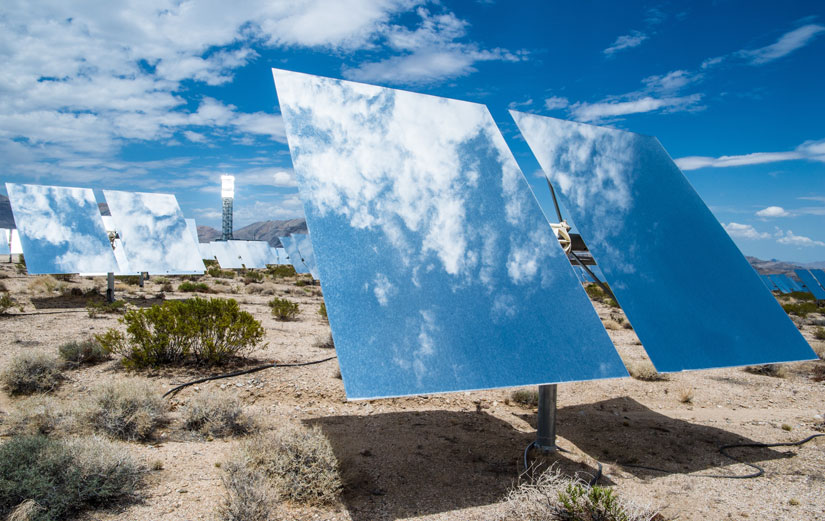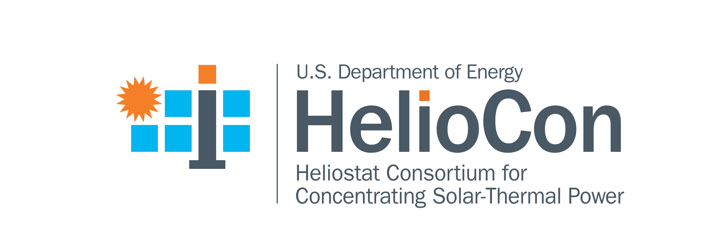Heliostat Consortium
The Heliostat Consortium (HelioCon) for Concentrating Solar-Thermal Power is focused on improving component performance for the concentrating solar-thermal power industry.

HelioCon—an NREL-led consortium—emphasizes the significance of heliostats as a key component of concentrating solar power (CSP) technologies. CSP with low-cost thermal energy storage can be used either to produce dispatchable electricity or provide high-temperature heat to difficult-to-decarbonize industries, such as cement, steel, and chemical production.

The consortium supports research, development, validation, commercialization, and deployment of low-cost and high-performance heliostats with optimized operations and maintenance for CSP and concentrating solar-thermal applications.
Within HelioCon, NREL, Sandia National Laboratories, and the Australian Solar Thermal Research Institute work closely with the U.S. Department of Energy (DOE) and CSP developers, component suppliers, utilities, and international experts.
Key Research Areas
HelioCon has a designated task lead for each research area. Within each area, the consortium focuses on developing results that will advance heliostat technologies.
- Advanced manufacturing
- Metrology and standards
- Components and controls development
- Field deployment
- Techno-economic analysis
- Resource, training, and education
Objectives
To advance U.S. heliostat technologies, HelioCon engages subject-matter experts and general stakeholders for direct project-level collaboration, external consulting, and mission-specific panels or workshops. HelioCon also serves as a hub to integrate all DOE-funded projects that directly advance heliostat technologies. HelioCon objectives are to:
- Develop strategic core capabilities and infrastructure to support high-performance heliostat manufacturing, validation, and optimization and facilitate industry's ability to design, manufacture, install, and operate central receiver heliostat fields with higher technical and economic performance
- Ensure that these capabilities are readily available to industry, meeting its needs
- Fund research on new technologies with significant potential to improve heliostat field economic performance
- Form U.S. centers of excellence focused on heliostat technology to restore U.S. leadership in heliostat research, development, and validation
- Promote workforce development through encouraging student internships and postdoctoral positions, the formation of a HelioCon early career scientist group to promote networking, and highlight existing training and educational programs in heliostat design, production, and operation.
Background
The consortium is funded by the Solar Energy Technologies Office through the FY 2022–2024 Lab Call. Working with industry, HelioCon is working to achieve DOE SunShot objectives for U.S.-manufactured heliostat cost, performance, and reliability.
A heliostat is a device that continually tilts a mirror or multiple mirror facets to track the sun's movement to reflect sunlight toward a predetermined target—such as a receiver sitting on top of a solar tower. Heliostats are a critical component of CSP and concentrating solar-thermal power tower technologies. A utility-scale heliostat field (100 MWe, for example) may include more than 10,000 heliostats. They represent 30%–50% of the cost of system construction and are a primary driver of operations and maintenance costs. Improvements to heliostat cost, performance, and reliability are necessary to achieve the DOE 2030 solar cost targets of 5 cents/kWh for CSP technology.
Team
HelioCon is led by experts around the world and consists of an Operations Team, Technical Area Leads, and a Board of Advisors.
The operations team is responsible for the day-to-day management and oversight of the consortium, driving the strategic vision and direction. The team gathers input from the board of advisors, members, other external stakeholders, and the U.S. Department of Energy.
Executive Director: Guangdong (GD) Zhu
Member at Large: Margaret Gordon
Partnership Director: Craig Turchi
Project Controller: Cindy Gerk
Communication Lead: Patrick Hayes
Agreement and Intellectual Property Lead: Jessica Roe
Board of Advisors Chair: Joseph Stekli
Australian Solar Thermal Research Institute Lead: Mike Collins
HelioCon Department of Energy Lead: Andru Prescod
Leads are responsible for strategic planning in their research areas by working with assembled subteams.
Advanced manufacturing: Randy Brost, Parthiv Kurup
Metrology and standards: Guangdong Zhu, Randy Brost
Components and controls development: Ken Armijo, Matt Muller
Field deployment: Jeremy Sment, Alex Zolan
Techno-economic analysis: Chad Augustine, Ken Armijo
Resource, training, and education: Rebecca Mitchell, Jeremy Sment
The board provides feedback, reviews the research portfolio and project performance on the development of core capabilities and infrastructure, and helps prioritize opportunities and capabilities.
- Mark Ayres, Tonopah Solar
- Yaniv Binyamin, BrightSource Energy
- Paul Gauche, Heliogen
- Randy Gee, SunDog
- Michel Izygon, Tietronix
- Sarah Kurtz, University of California Merced
- Michael Munroe, NRG Energy
- Andreas Pfahl, German Aerospace Institute
- Hank Price, Solar Dynamics
- Marc Röger, German Aerospace Institute
- Joseph Stekli, Electric Power Research Institute
- Matthew Thibodeau, Sargent and Lundy
- Kimani Toussaint, Brown University
Contact
To participate and get the latest updates, contact the HelioCon team at heliostat.consortium@nrel.gov.
Share

